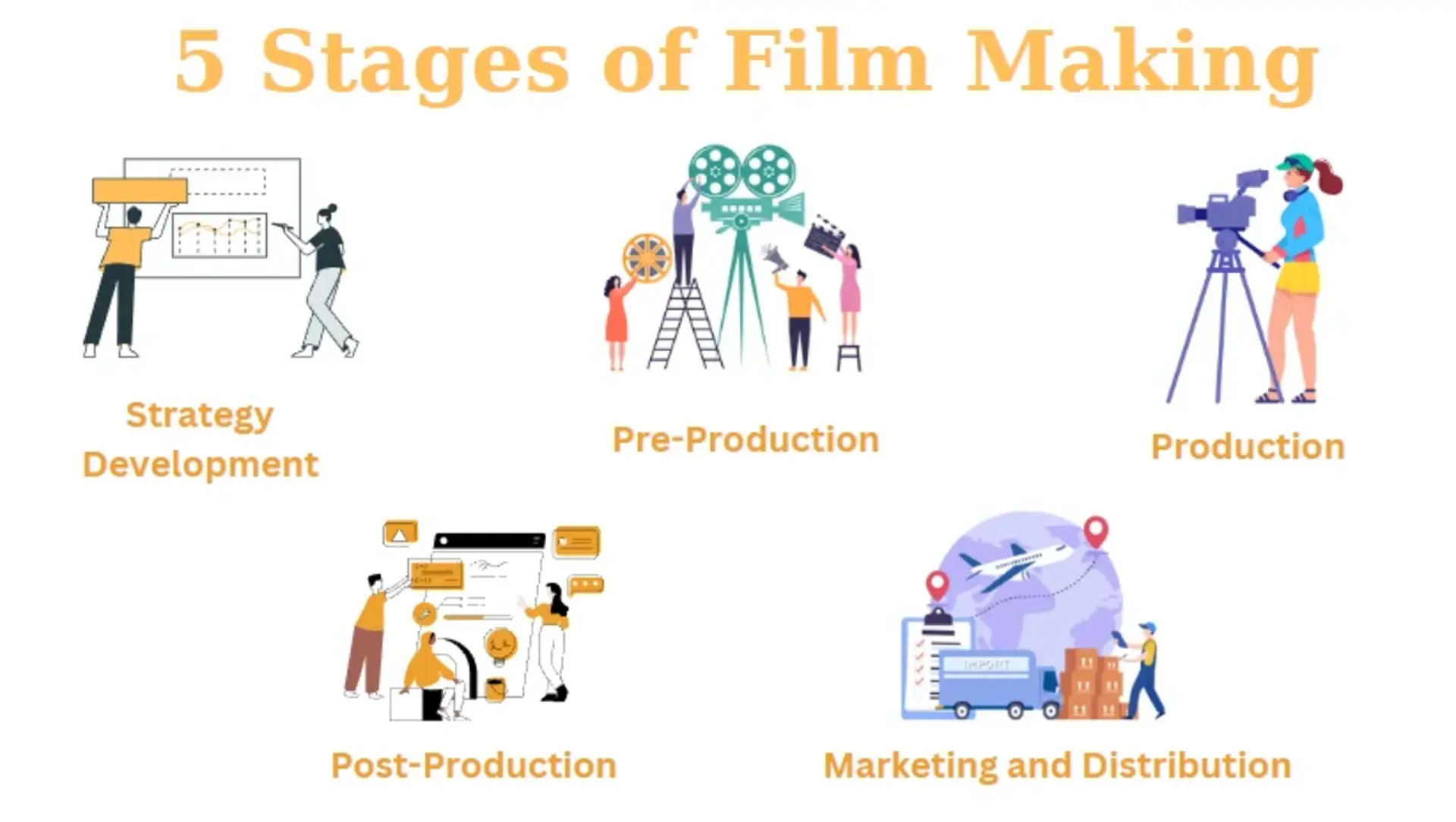What is Film Production?
Film production is the essential process within the filmmaking industry that brings stories to life on the screen. It involves a series of interconnected stages, each requiring diverse professionals and skill sets. At its core, film production is a collaborative effort where a team of creatives transforms a written story and script into a visual narrative for audiences to enjoy.
This intricate process encompasses various roles, such as editing, producing, and film distribution, all working in tandem to create a motion picture. Film production goes beyond the shooting stage, involving extensive planning, creativity, and coordination among the production team. From selecting locations to securing funding, the production crew is responsible for every aspect that contributes to the final cinematic experience.
Exploring the 5 Stages of Filmmaking
Exploring the five stages of filmmaking is essential for anyone interested in the industry, offering valuable insights into the complexities involved in realizing a film project. The process unfolds in five distinct stages, each playing a crucial role in transforming an idea into a compelling visual narrative. Let’s delve into the intricacies of these stages and unravel the magic that goes on behind the scenes.
1. Development: The Birth of an Idea
The journey commences in the development stage, where a project producer gathers the seeds of an idea, often sourced from books, plays, or original concepts. This phase involves crafting the screenplay, creating storyboards, and preparing a synopsis to pitch the project for funding. A delicate dance between creativity and business development sets the foundation for the entire filmmaking process.
Intricate networking and meetings follow, especially in cinematic hubs, where producers seek potential financiers. The aim is to secure the necessary funds to breathe life into the envisioned project, paving the way for the subsequent stages.
2. Pre-Production: Crafting the Blueprint
With funding in hand, pre-production unfurls as a meticulous planning and preparation period. It encompasses a range of tasks, from casting and crew selection to location scouting, set design, and prop creation. Budgeting becomes a crucial tool, guiding the spending plan and prioritizing needs to ensure a smooth production.
Key players, including the director, producer, and assistant director, collaborate to create a detailed schedule and shot lists. Actors undergo rehearsals, and the production team gears up for the demanding shoot ahead. Pre-visualization techniques, such as storyboards and concept art, aid in determining the film’s visual aesthetics.
3. Production: Lights, Camera, Action!
Known as principal photography, the production stage is where the film is physically shot. The assistant director takes center stage, coordinating various teams simultaneously. Actors, having undergone extensive rehearsals, bring characters to life, while the production crew works tirelessly on the technical aspects of lighting, sound, and cinematography.
Despite meticulous planning, the unpredictability of Murphy’s Law hovers over every set, demanding adaptability and problem-solving skills. The director takes the creative helm, making decisions that shape the film’s visual narrative. The culmination of this stage marks the completion of the raw footage, ready for the transformative journey that lies ahead.
4. Post-Production: Crafting the Final Masterpiece
Post-production is the realm where the editor, often in collaboration with the director, weaves together the raw footage into a cohesive narrative. The process involves multiple stages, starting with the assembly cut, a rough sketch of the film’s structure. Subsequent phases, including the rough cut, fine cut, and picture lock, refine the edit, ensuring a seamless flow.
Simultaneously, other departments dive into their tasks: visual effects teams enhance the visual elements, sound designers orchestrate the film’s score, and color correction experts add the finishing touches. The result is a polished, final edit ready for the audience.
5. Marketing and Distribution: Bringing the Film to the World
In the realm of marketing, teasers, promotional posters, festival screenings, and social media become crucial tools to generate buzz for the film. Major production companies may secure exclusive deals with platforms for a lucrative release, while smaller productions might navigate multiple streaming platforms.
The distribution phase, once centered around physical copies, has evolved with the dominance of streaming services. Theatrical releases, television, Blu-ray, and streaming platforms provide diverse avenues for audiences to experience the film. The journey concludes with press interviews, red carpet premieres, and launch parties, marking the film’s introduction to the world.
Conclusion
Film production is a collaborative journey that transforms ideas into captivating visual narratives. The five stages—Development, Pre-Production, Production, Post-Production, and Marketing/Distribution—require meticulous planning and creativity. It begins with crafting the screenplay and securing funding, followed by detailed planning, shooting, and editing. Marketing generates buzz, and distribution ensures the film reaches diverse audiences. Each stage involves diverse professionals working together to create a polished masterpiece.
Ready to embark on your ad film production journey? Explore each stage with passion and dedication, and bring your stories to life on the big screen!
FAQ’s
What is done in film production?
Film production involves transforming a written story into a visual narrative. It includes planning, creativity, and coordination among various roles such as editing, producing, and distribution.
What are the 5 stages of film production?
The five stages of film production are:
- Development: Gathering ideas, crafting the screenplay, and seeking funding.
- Pre-Production: Meticulous planning, including casting and set design.
- Production: Physical shooting, with actors bringing characters to life.
- Post-Production: Editing, refining footage, and adding effects and sound.
- Marketing and Distribution: Using teasers and various platforms to generate buzz and reach audiences.
How do I market through ad film production?
Marketing through ad film production involves:
- Crafting a Compelling Story: Develop a resonant narrative to effectively convey your message.
- Utilizing Visual Appeal: Create engaging content that captures attention through the visual medium.
- Social Media Promotion: Use platforms like Instagram, Facebook, and Twitter for teasers and engagement.
- Collaborating with Influencers: Partner with influencers to expand reach and align with your brand.
- Film Festival Participation: Submit to festivals for exposure and recognition.
- Strategic Distribution: Choose platforms aligning with your target audience.
- Interactive Campaigns: Encourage audience participation through contests or challenges.


